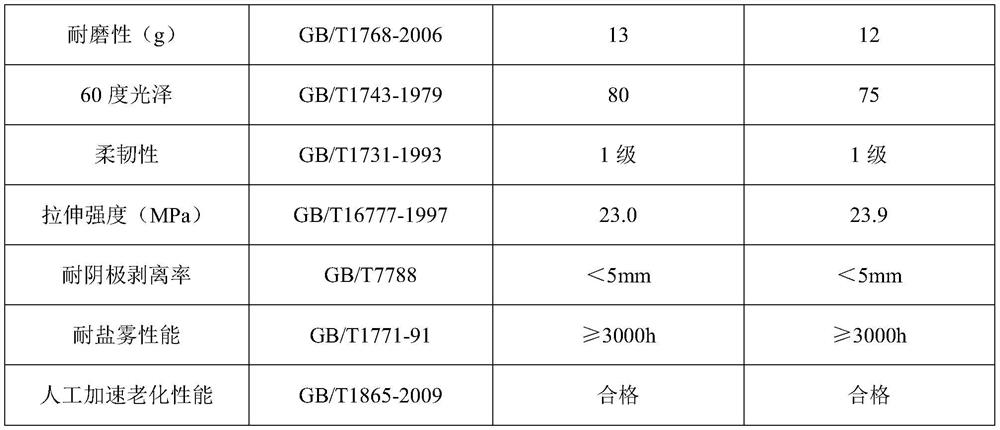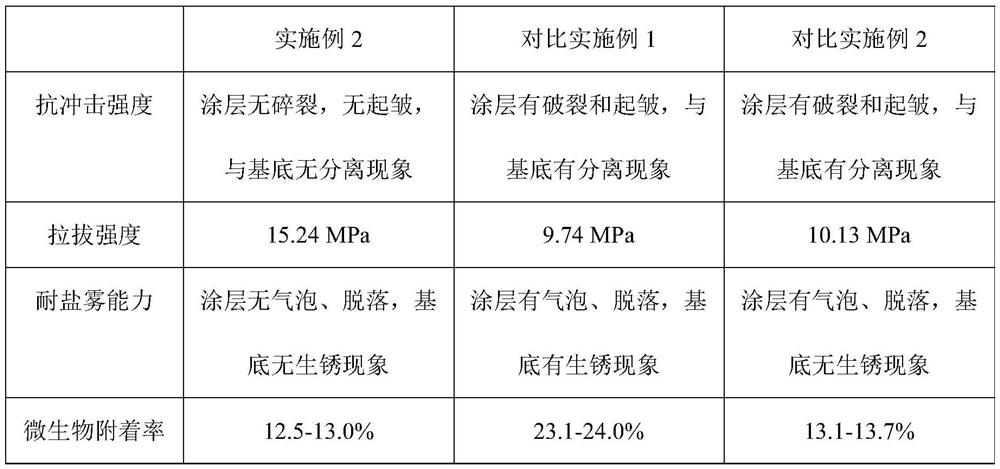A kind of ocean engineering anticorrosion polyurea coating and preparation method thereof
A marine engineering and polyurea technology, applied in anti-corrosion coatings, polyurea/polyurethane coatings, anti-fouling/underwater coatings, etc., can solve the problems of unsatisfactory bonding force between anti-corrosion polyurea coatings and metal structures and unsatisfactory anti-corrosion effects , to achieve the effect of strong reciprocating force, strong antibacterial effect, and not easy to fall off
- Summary
- Abstract
- Description
- Claims
- Application Information
AI Technical Summary
Problems solved by technology
Method used
Image
Examples
Embodiment 1
[0050] The preparation of embodiment 1 modified nano titanium dioxide
[0051] Disperse 50 parts of nano-titanium dioxide in a hydrogen peroxide solution with a concentration of 25%, stir for 30 minutes, filter, wash with acetone, and dry; disperse the dried nano-titanium dioxide in water, add 5 parts of surfactant triethanolamine, Adjust the pH to 5.0, add 3 parts of silane coupling agent KH560, ultrasonically disperse evenly, add dropwise silver nitrate solution and copper sulfate solution to a final concentration of 0.05mol / L, raise the temperature to 90°C after the dropwise addition, stir for 25 minutes, drop to room temperature, centrifuged and dried to obtain modified nano-titanium dioxide.
Embodiment 2
[0055] The preparation of embodiment 2 anticorrosion polyurea coatings
[0056] S1: Dehydrate 34 parts of polycarbonate diol at 120°C and a vacuum of -0.08Mpa for 2 hours, and lower it to room temperature for later use;
[0057] S2: Put 66 parts of diphenyltoluene diisocyanate into the reaction kettle, raise the temperature to 45°C, slowly add polycarbonate diol dropwise, after the addition, raise the temperature to 80°C, keep it warm for 2 hours, take samples to measure the NCO content, when NCO When the content is 19.0%, it is lowered to room temperature, filtered, filled with nitrogen and sealed for future use;
[0058] S3: Put 34 parts of amino-terminated polyether D2000 into the mixing tank, add 30 parts of diethyltoluenediamine, 10 parts of 4,4-bis-sec-butylaminodiphenylmethane, stir for 0.5 hours, add hydroxyethyl ethylene diamine 5 parts of amine triacetic acid, 8 parts of Sea-Nine211, 14.7 parts of composite zinc aluminum phosphate, 0.3 part of fumed silicon dioxide,...
Embodiment 3
[0059] The preparation of embodiment 3 anticorrosion polyurea coatings
[0060] S1: Dehydrate 50 parts of polycarbonate diol at 110°C and a vacuum of -0.08Mpa for 2 hours, and lower it to room temperature for later use;
[0061] S2: Put 70 parts of diphenyltoluene diisocyanate into the reaction kettle, raise the temperature to 50°C, slowly add polycarbonate diol dropwise, after the addition, raise the temperature to 80°C, keep it warm for 2 hours, take samples to measure the NCO content, when NCO When the content is 20.0%, it is lowered to room temperature, filtered, filled with nitrogen and sealed for future use;
[0062] S3: Put 40 parts of amino-terminated polyether T5000 into the mixing tank, add 30 parts of diethyltoluenediamine, 10 parts of 4,4-bis-sec-butylaminodiphenylmethane, stir for 0.5 hours, add dihydroxyethylglycine 5 parts, 10 parts of Sea-Nine211, 17 parts of composite zinc-aluminum phosphate, 0.5 part of fumed silica, then add 4 parts of modified nano-titaniu...
PUM
| Property | Measurement | Unit |
|---|---|---|
| particle diameter | aaaaa | aaaaa |
| tensile strength | aaaaa | aaaaa |
Abstract
Description
Claims
Application Information
 Login to View More
Login to View More - R&D
- Intellectual Property
- Life Sciences
- Materials
- Tech Scout
- Unparalleled Data Quality
- Higher Quality Content
- 60% Fewer Hallucinations
Browse by: Latest US Patents, China's latest patents, Technical Efficacy Thesaurus, Application Domain, Technology Topic, Popular Technical Reports.
© 2025 PatSnap. All rights reserved.Legal|Privacy policy|Modern Slavery Act Transparency Statement|Sitemap|About US| Contact US: help@patsnap.com



